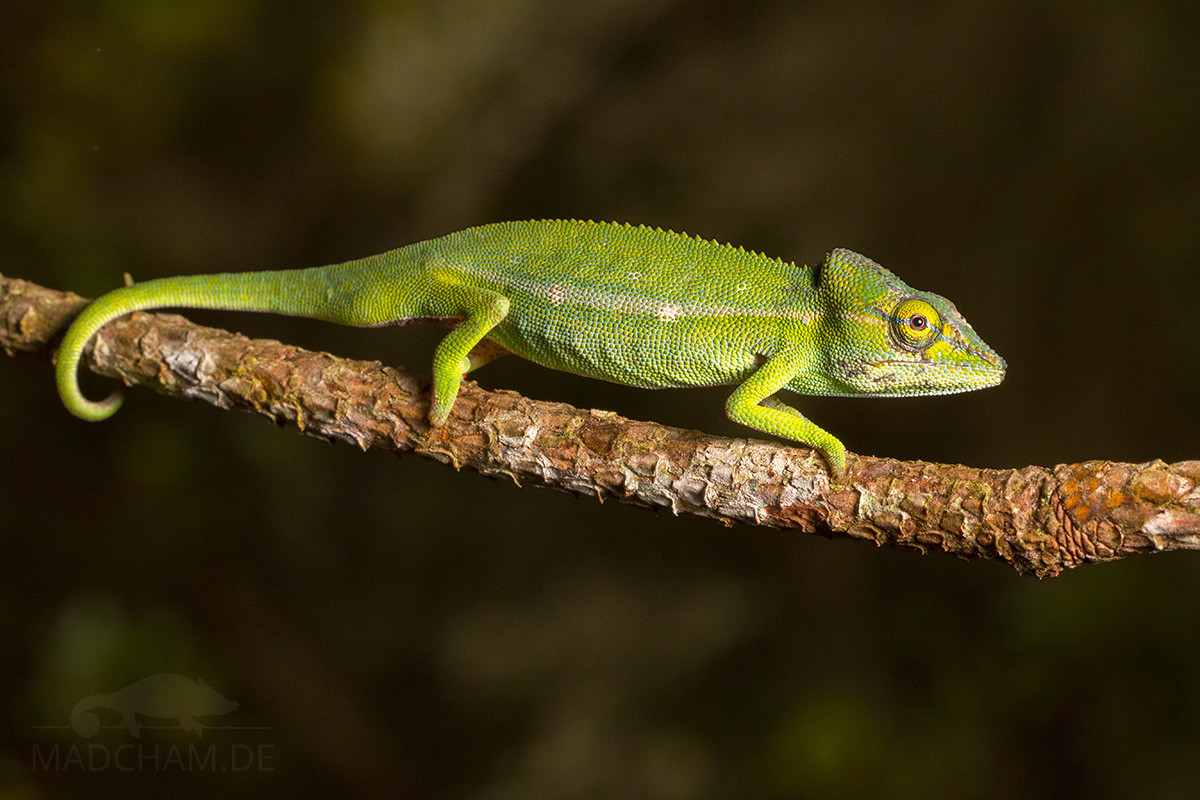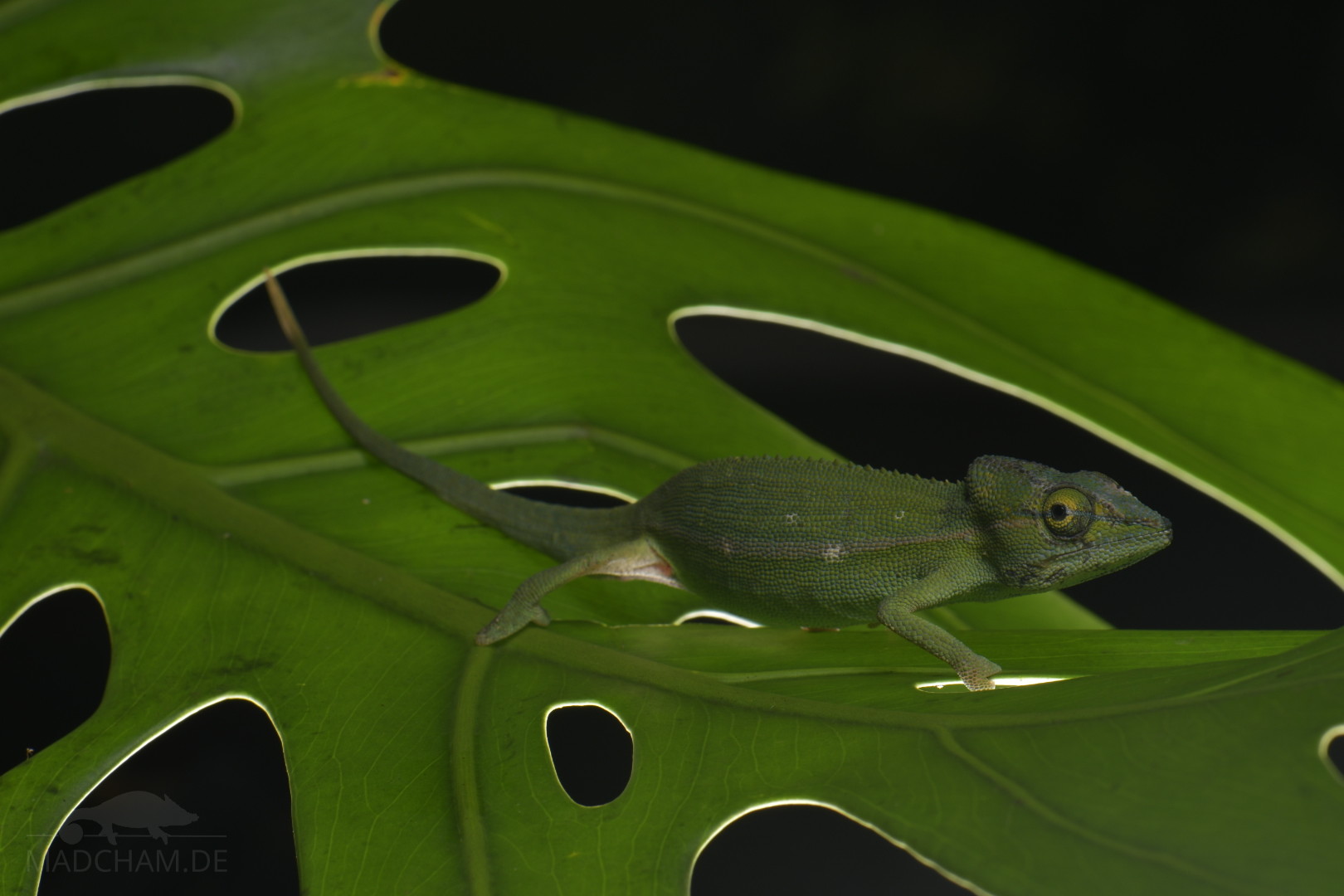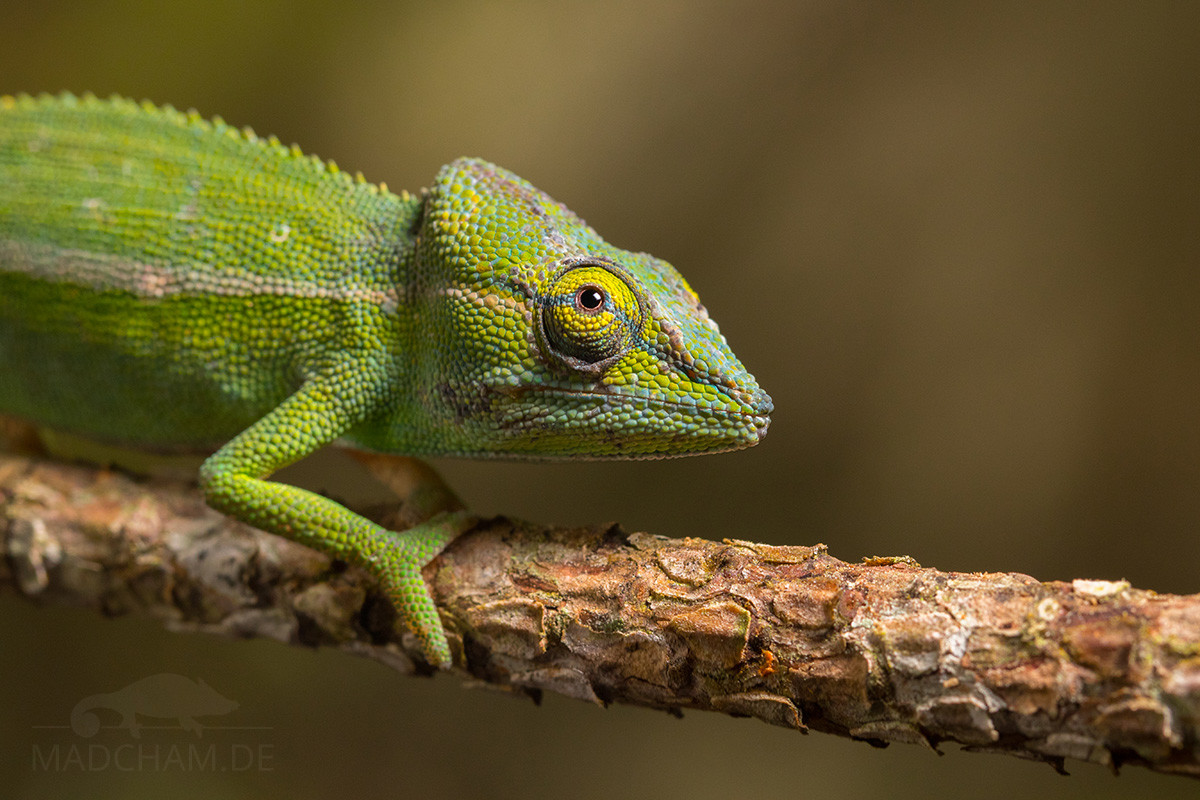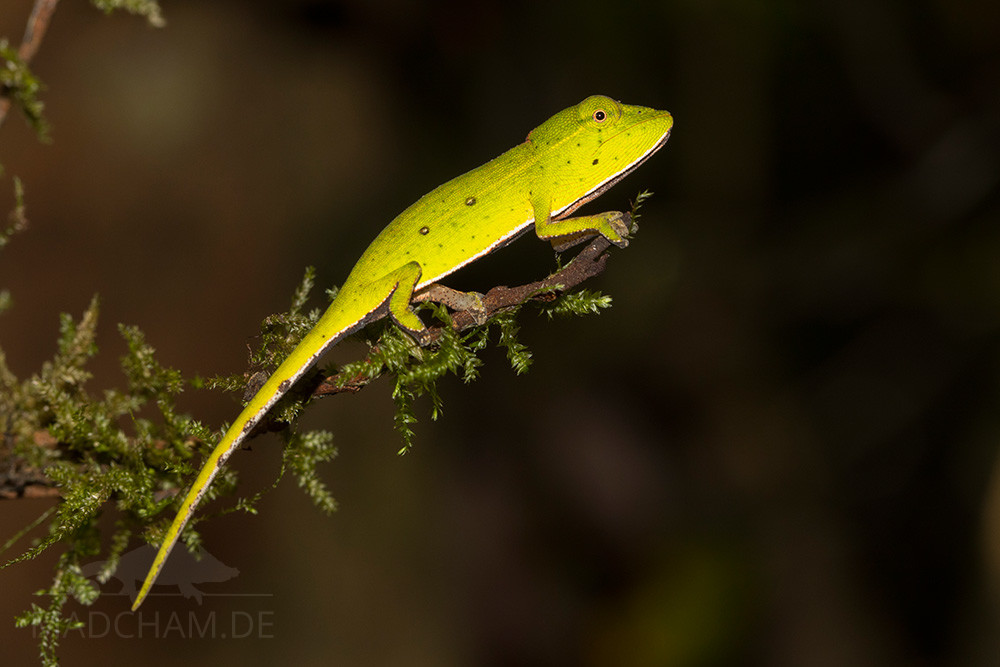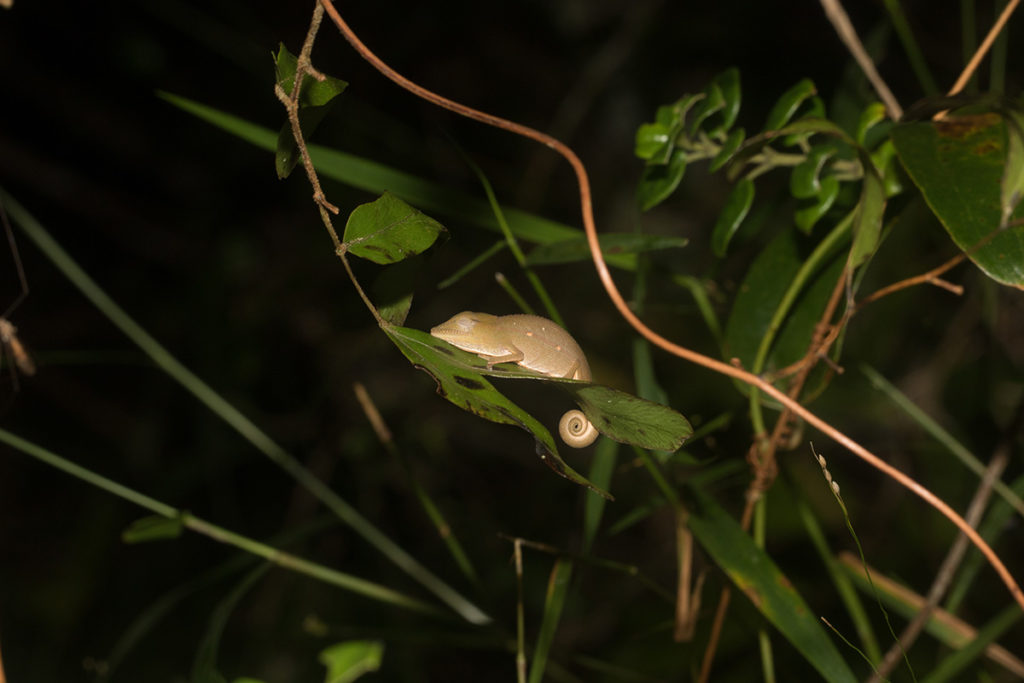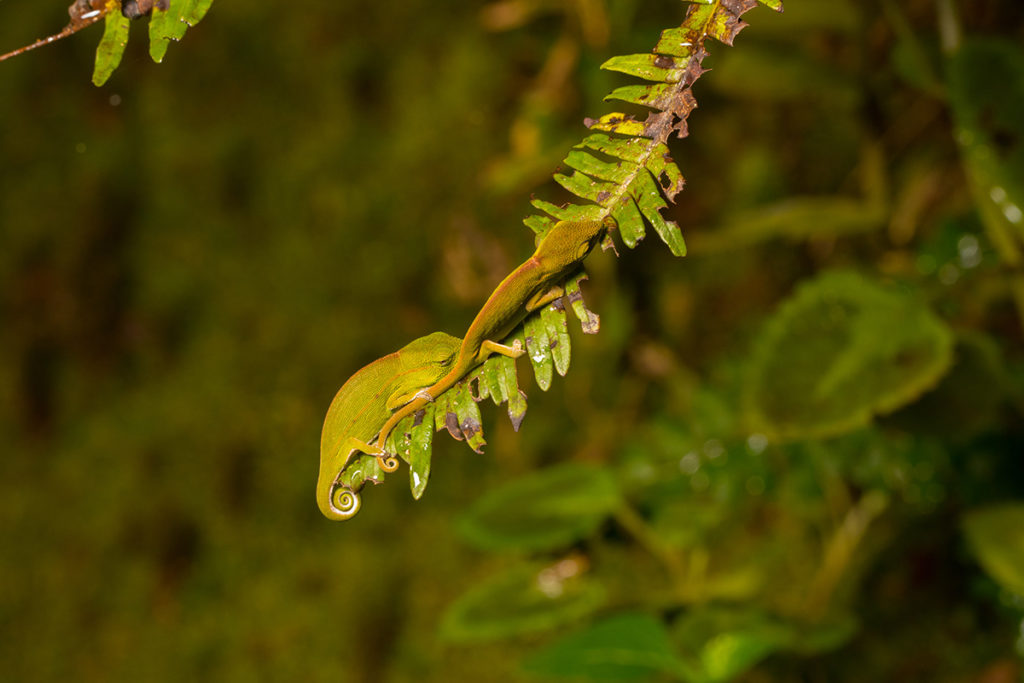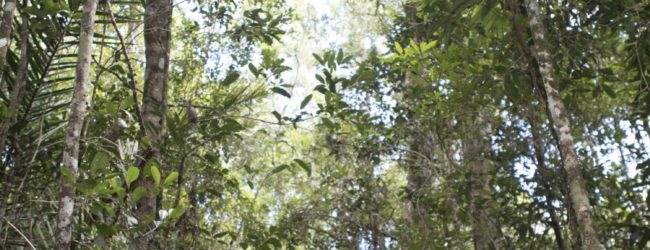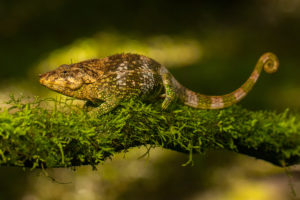2011-13 no specimens, 2014-16 each 500 specimens, 2017 for the first time 1000, 2018-2022 each 500 specimens, 2023 only 300 specimens and 2024 again 500 specimens for legal export
First description:
(Boulenger, 1888)
Origin of the species name:
The Belgian zoologist George Alber Boulenger, at that time working at the Natural History Museum in London (Great Britain), probably named this chameleon species after the Latin gastro taenia, which can be translated as “belly band”. This probably refers to the white lateral stripes of the males.
Distribution:
Calumma gastrotaenia belongs to the chameleon species that prefer living in the dense rainforests of the eastern highlands. We could find this chameleon species at elevations of 1200 meters above sea level. Lucky people can find these small chameleons in the rainforests of Analamazaotra in high shrubs as well as along the road to Andasibe at night sleeping on small branches. Over the last years, we have been watching a strong decrease in specimen numbers, and up to date, this species can only rarely be found anymore in Andasibe. The best place to see the animals is Anjozorobe in the northern highlands of Madagascar. In spring you can find whole “kindergartens” of this species in the forest at only a few hundred meters.
Appearance and size:
Calumma gastrotaenia belongs to the small or mid-sized chameleon species. Males reach a length of 14 cm, while females grow up to 13 cm. Scalation is homogenous, with a small dorsal crest in males. The males’ color is bright green with yellow accents and a white lateral stripe from the eye to the tail that may be bright blue above the eyelids. The casque rises in direction to the back, in females, it stays low. The ventral crest has two parallel running white lines. During mating time, Calumma gastrotaenia sometimes also show blue accents. The young specimens are bright green and really tiny.
Reproduction:
Young Calumma gastrotaenia hatch from January to March, they are easier to find because they always sleep at the end of leaves.
| Jan | Feb | Mar | Apr | May | Jun | Jul | Aug | Sep | Oct | Nov | Dec | |
| Average temperature | 23 | 24 | 23 | 23 | 22 | 19 | 19 | 19 | 20 | 21 | 22 | 23 |
| Minimum temperature | 20 | 20 | 20 | 19 | 18 | 15 | 15 | 15 | 15 | 16 | 18 | 19 |
| Maximum temperature | 27 | 27 | 27 | 27 | 25 | 23 | 23 | 23 | 24 | 25 | 26 | 27 |
| Rain days | 27 | 24 | 26 | 19 | 17 | 18 | 21 | 20 | 15 | 16 | 20 | 25 |
We have collected the data given above over several years with thermometers and hygrometers at the finding places of the chameleons. "Average temperature" means that values of a whole month have been calculated to one average value per month. For example all measured minimum temperature values of February have been calculated to one average minimum temperature for February. In plain language, this means single peak values of a day may be a little higher or lower than the average minimum and maximum temperatures. It is possible that a location has an average maximum temperature of 29°C, but one day during that month it had 33°C or even 35°C there.
Three examples of a daily course of temperatures in Andasibe in the rainy season can be found below. Both were recorded with data loggers in 2023.



The region around Andasibe with the associated forests of Mantadia, Mitsinjo and Analamazaotra lie in the eastern highlands of Madagascar at altitudes between 900 and 1250 m above sea level. During the day, the temperature may sometimes exceed 25°C, but the thermometer rarely climbs above 30°C, or only in sunspots. At night, temperatures plummet, especially during the dry season. 10° to 15° degrees are the rule.
Humidity in the rainforests around Andasibe is high all year round. During the rainy season it rains extensively every day, sometimes the rain lasts for days. But the dry season is not massively different either, except that it has slightly cooler temperatures overall and reaches lower temperatures at night. It still rains at least every other day. Rain, high humidity and a drop in temperature at night are therefore the central points of Andasibe's climate. In 2023, we measured relative humidity with data loggers on different days in Andasibe in the rainy season, the data can be found below.

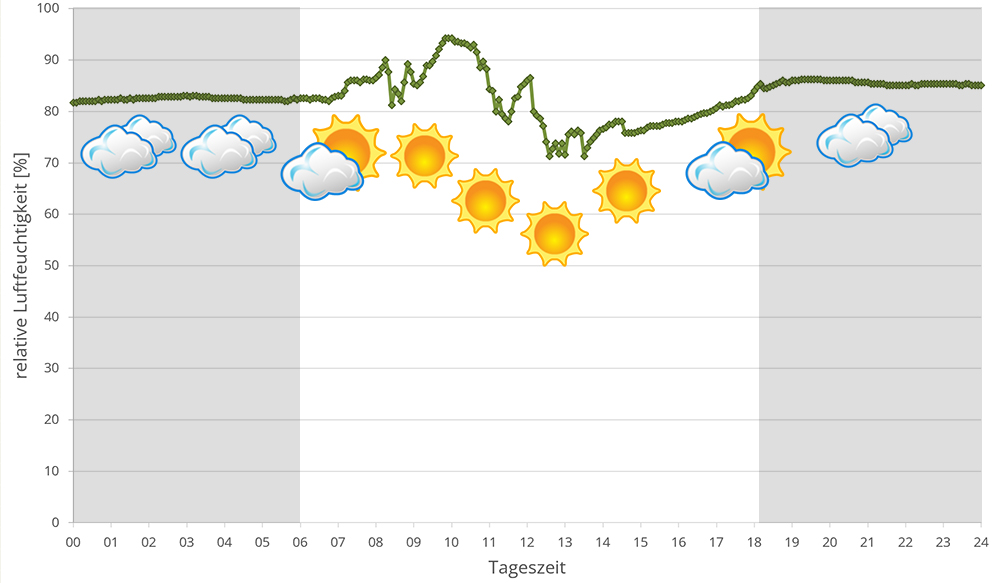


 Tageszeit = day time, Sonne = sun, Halbschatten = half shade, Schatten = shade
Tageszeit = day time, Sonne = sun, Halbschatten = half shade, Schatten = shade
We have measured UVB data with a Solarmeter 6.5 in spring (March, April) at the peak of activity of chameleons in Madagascar. We always measured the values that a chameleon could maximally reach in its habitat.
| Jan | Feb | Mar | Apr | May | Jun | Jul | Aug | Sep | Oct | Nov | Dec | |
| Morning | 23,2 | 23,4 | 22,0 | 22,1 | 20,5 | 16,0 | 16,3 | 16,5 | 17,4 | 16,7 | 21,2 | - |
| Midday | 25,4 | 25,3 | 24,5 | 22,5 | 20,2 | 16,5 | 16,3 | 17,7 | 18,3 | 18,0 | 21,4 | - |
| Evening | 25,5 | 25,1 | 25,0 | 25,3 | 20,8 | 17,2 | 16,1 | 17,0 | 19,6 | 23,0 | 22,0 | - |
Between 21 March 2018 and 05 February 2019, we measured ground temperatures in the rainforest of Andasibe and surrounding areas (Analamazaotra, Andasibe, V.O.I.M.M.A. and Mitsinjo) about every other day - the table is the result of these measurements. Only in December no measurements were taken. detailed review can be found here. In total, we took 418 soil temperature measurements and measured an estimated 70 different locations in Andasibe and the surrounding area at a depth of 20 cm.
In 2023, in addition to other climate data, we also measured the air pressure at the locations we visited in Madagascar. The following data is from different days during the rainy season in Andasibe. On the X-axis is the time of day or night. In Madagascar, the day begins around 6 am, and night falls at 6 pm. The Y-axis shows the atmospheric pressure in hPa.



Habitat:
The following pictures show the habitat of Calumma gastrotaenia in the rainforests of Andasibe and Anjozorobe. Both rainforests are rather dense with small clearings in between. The animals live on slender trees and in high bushes.
Below you will find some 360° images from the rainforests of Analamazaotra and Anjozorobe that we took during the rainy season. If you click on the respective image, the pictures will open in an enlarged view in a separate window. You can use the mouse to rotate in all directions. You also have the option of running the images in full-screen mode. Enjoy!

